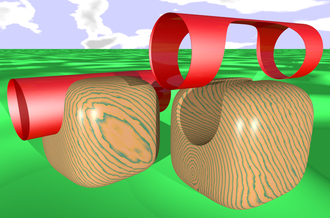User:Ag2gaeh/playground


Triangulation of a surface means
- a) a net of triangles, which covers a given surface partly or totaly or
- b) the procedure of generating the points and triangles of such a net of triangles.
In this article the generation of a net of triangles will be described. In literature there are contributions which deal with the optimization of a given net.
Surface triangulations are important for
- visualizing surfaces and
- the application of finite element methods.
The triangulation of a parametrically defined surface is an easy task. You just triangulate the area of definition (s. 2. picture). But the images of these triangles in object space may vary in shape and extension, which may be a drawback. This drawback can be minimized by adaptive methods, which use 3D-informations (step width) while triangulating the parameter area.
To triangulate an implicit surface (defined by one or more equations) is more difficult. There exist essentially two methods: a) One method devides the 3D-area of consideration into cubes and determines the intersections of the surface with the edges of the cubes in order to get polygons on the surface, which thereafter have to be triangulated (cutting cube method)[1], [2]. The expenditure for managing the data is great. b) The second and more simple concept is the idea of the marching method [3],[4], [5] The triangulation starts with a triangulated hexagon at a starting point. Step by step there will be added new triangles following given rules until the surface of consideration is triangulated. If the surface consists of several components, the algorithm has to be started several times using suitable starting points. The cutting cube algorithm determines at the same time all components of the surface within the surrounding starting cube depending on presribed limit parameters. An advantage of the marching method is the possibility to prescribe boundaries (s. picture).
Polygonizing a surface means to generate a polygon mesh.
The triangulation of a surface should not be confused with the triangulation of a discrete prescribed plane set of points. See Delaunay triangulation.
-
Triangulation: cylinder, surface
-
Triangulation: cylinder, surface , povray-image
-
Torus: triangulated by the marching method
-
Torus: polygonized by the cutting cube method
See also[edit]
- Computer-aided design
References[edit]
- ^ M. Schmidt: Cutting Cubes - visualizing implicit surfaces by adaptive polygonization. Visual Computer (1993) 10, p. 101-115
- ^ J. Bloomenthal: Polygonization of implicit surfaces, Computer Aided Geometric Design (1988), p. 341-355
- ^ E. Hartmann: Geometry and Algorithms for COMPUTER AIDED DESIGN, p. 81
- ^ E. Hartmann: A marching method for the triangulation of surfaces, The Visual Computer (1998), 14, p. 95-108
- ^ S. Akkouche & E Galin: Adaptive Implicit Surface Polygonization Using Marching Triangles, COMPUTER GRAPHICS forum (2001), Vol. 20, p. 67-80
Weblinks[edit]
- Tasso Karkanis & A. James Stewart: Curvature-Dependent Triangulation of Implicit Surfaces [1]





